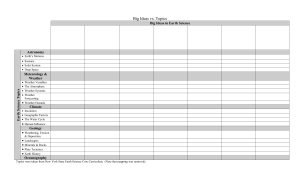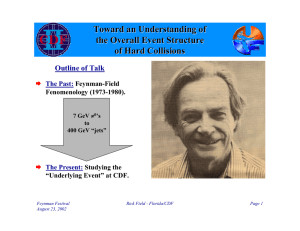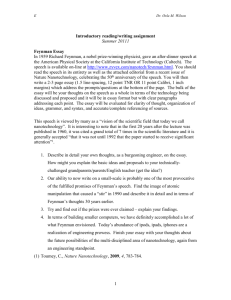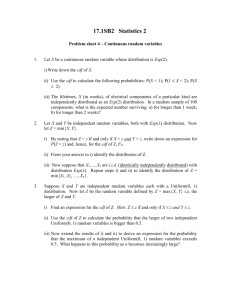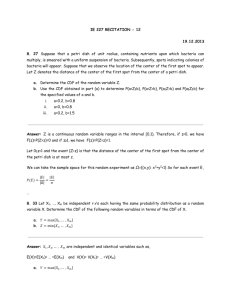PPT
advertisement
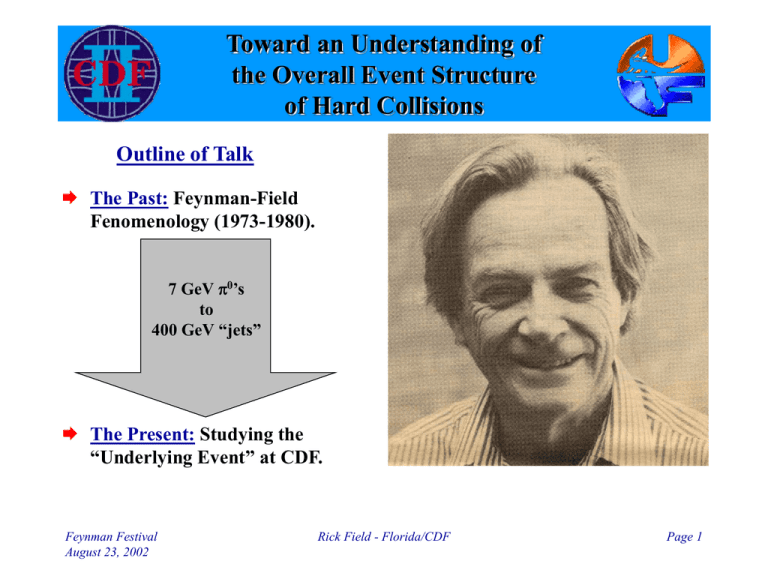
Toward an Understanding of the Overall Event Structure of Hard Collisions Outline of Talk The Past: Feynman-Field Fenomenology (1973-1980). 7 GeV p0’s to 400 GeV “jets” The Present: Studying the “Underlying Event” at CDF. Feynman Festival August 23, 2002 Rick Field - Florida/CDF Page 1 CDF Collider Phenomenology Proton In addition to being an exceptional theoretical CDF 1 mile physicist (and very good at math!), Feynman was a great phenomenologist and he enjoyed very much talking with experimenters. AntiProton Theorist! I am a theorist working in the CDF experimental collaboration. I work on collider phenomenology related to CDF. Proton 2 TeV AntiProton Only by working in the experimental collaboration am I able to have access to data and do the kind of phenomenology I enjoy (i.e. the kind of phenomenology I did with Feynman many years ago). Feynman Festival August 23, 2002 Rick Field - Florida/CDF Page 2 Feynman-Field Fenomenology 1973-1980 “Feynman-Field Jet Model” FF1: “Quark Elastic Scattering as a Source of High Transverse Momentum Mesons”, R. D. Field and R. P. Feynman, Phys. Rev. D15, 2590-2616 (1977). FFF1: “Correlations Among Particles and Jets Produced with Large Transverse Momenta”, R. P. Feynman, R. D. Field and G. C. Fox, Nucl. Phys. B128, 1-65 (1977). FF2: “A Parameterization of the properties of Quark Jets”, R. D. Field and R. P. Feynman, Nucl. Phys. B136, 1-76 (1978). F1: “Can Existing High Transverse Momentum Hadron Experiments be Interpreted by Contemporary Quantum Chromodynamics Ideas?”, R. D. Field, Phys. Rev. Letters 40, 997-1000 (1978). FFF2: “A Quantum Chromodynamic Approach for the Large Transverse Momentum Production of Particles and Jets”, R. P. Feynman, R. D. Field and G. C. Fox, Phys. Rev. D18, 3320-3343 (1978). FW1: “A QCD Model for e+e- Annihilation”, R. D. Field and S. Wolfram, Nucl. Phys. B213, 65-84 (1983). My 1st graduate student! Feynman Festival August 23, 2002 Rick Field - Florida/CDF Page 3 Feynman-Field Fenomenology 1973-1980 “Feynman-Field Jet Model” FF1: “Quark Elastic Scattering as a Source of High Transverse Momentum Mesons”, R. D. Field and R. P. Feynman, Phys. Rev. D15, 2590-2616 (1977). FFF1: “Correlations Among Particles and Jets Produced with Large Transverse Momenta”, R. P. Feynman, R. D. Field and G. C. Fox, Nucl. Phys. B128, 1-65 (1977). Many people have to our of understanding FF2: “A Parameterizationcontributed of the properties Quark Jets”, R. D. Field and R. P. hadron-hadron collisions! Feynman, Nucl. Phys. B136,of 1-76 (1978). I will sayMomentum a few words about Experiments be F1: “Can Existing High Transverse Hadron Feynman’s influence on the field. Ideas?”, R. D. Field, Interpreted by Contemporary Quantum Chromodynamics Phys. Rev. Letters 40, 997-1000 (1978). FFF2: “A Quantum Chromodynamic Approach for the Large Transverse Momentum Production of Particles and Jets”, R. P. Feynman, R. D. Field and G. C. Fox, Phys. Rev. D18, 3320-3343 (1978). FW1: “A QCD Model for e+e- Annihilation”, R. D. Field and S. Wolfram, Nucl. Phys. B213, 65-84 (1983). My 1st graduate student! Feynman Festival August 23, 2002 Rick Field - Florida/CDF Page 4 Hadron-Hadron Collisions FF1 1977 (preQCD) What happens when two hadrons collide at high energy? Hadron Most of the time the hadrons ooze through each other and fall apart (i.e. no hard scattering). The outgoing particles continue in roughly the same direction as initial proton and antiproton. Occasionally there will be a large transverse momentum meson. Question: Where did it come from? Hadron ??? Parton-Parton Scattering Outgoing Parton Hadron We assumed it came from quark-quark elastic scattering, but we did not know how to calculate it! Hadron Outgoing Parton high PT meson “Black-Box Model” Feynman Festival August 23, 2002 Rick Field - Florida/CDF Page 5 Hadron-Hadron Collisions FF1 1977 (preQCD) What happens when two hadrons collide at high energy? Hadron ??? Hadron Feynman quote from FF1: Most of the time the hadrons ooze “The model we shall choose is not a popular one, through each other and fall apart (i.e. so that we will not duplicate too much of the no hard scattering). The outgoing work of others who are similarly analyzing particles continue in roughly the same various models (e.g. constituent interchange Parton-Parton Scattering Outgoing Parton direction as initial proton model,and multiperipheral models, etc.). We shall assume that the high PT particles arise from antiproton. “Soft” Collision (no large transverse momentum) direct hard collisions between constituent Occasionally there will be a large quarks in the incoming particles, which Hadron fragment or cascade down into several hadrons.” transverse momentum meson. Hadron Question: Where did it come from? We assumed it came from quark-quark elastic scattering, but we did not know how to calculate it! Outgoing Parton high PT meson “Black-Box Model” Feynman Festival August 23, 2002 Rick Field - Florida/CDF Page 6 Quark-Quark Black-Box Model Quark Distribution Functions determined from deep-inelastic lepton-hadron collisions FF1 1977 (preQCD) Quark-Quark Cross-Section Unknown! Deteremined from hadron-hadron collisions. Feynman Festival August 23, 2002 No gluons! Rick Field - Florida/CDF Quark Fragmentation Functions determined from e+e- annihilations Page 7 Quark-Quark Black-Box Model Quark Distribution Functions determined from deep-inelastic lepton-hadron collisions No gluons! FF1 1977 (preQCD) Feynman quote from FF1: “Because of the incomplete knowledge of our functions some things can be predicted with more certainty than others. Those experimental results that are not well predicted can be “used up” to determine these functions in greater detail to permit better predictions of further experiments. Our papers will be a bit long because we wish to discuss this interplay in detail.” Quark-Quark Cross-Section Unknown! Deteremined from hadron-hadron collisions. Feynman Festival August 23, 2002 Rick Field - Florida/CDF Quark Fragmentation Functions determined from e+e- annihilations Page 8 Predict particle ratios Quark-Quark Black-Box Model FF1 1977 (preQCD) Predict increase with increasing CM energy W Predict overall event topology (FFF1 paper 1977) Feynman Festival August 23, 2002 Rick Field - Florida/CDF Page 9 Telagram from Feynman July 1976 SAW CRONIN AM NOW CONVINCED WERE RIGHT TRACK QUICK WRITE FEYNMAN Feynman Festival August 23, 2002 Rick Field - Florida/CDF Page 10 Letter from Feynman July 1976 Feynman Festival August 23, 2002 Rick Field - Florida/CDF Page 11 Letter from Feynman: page 1 Spelling? Feynman Festival August 23, 2002 Rick Field - Florida/CDF Page 12 Letter from Feynman: page 3 It is fun! Onward! Feynman Festival August 23, 2002 Rick Field - Florida/CDF Page 13 Napkin from Feynman Feynman Festival August 23, 2002 Rick Field - Florida/CDF Page 14 QCD Approach Quarks & Gluons Quark & Gluon Fragmentation Functions 2 Q dependence predicted from QCD FFF2 1978 Parton Distribution Functions Q2 dependence predicted from QCD Quark & Gluon Cross-Sections Calculated from QCD Feynman Festival August 23, 2002 Rick Field - Florida/CDF Page 15 QCD Approach Quarks & Gluons Quark & Gluon Fragmentation Functions 2 Q dependence predicted from QCD Parton Distribution Functions Q2 dependence predicted from QCD FFF2 1978 Feynman quote from FFF2: “We investigate whether the present experimental behavior of mesons with large transverse momentum in hadron-hadron collisions is consistent with the theory of quantum-chromodynamics (QCD) with asymptotic freedom, at least as the theory is now partially understood.” Quark & Gluon Cross-Sections Calculated from QCD Feynman Festival August 23, 2002 Rick Field - Florida/CDF Page 16 QCD Approach Quarks & Gluons FFF2 1978 Predict large “jet” cross-section Feynman quote from FFF2: “At the time of this writing, there is still no sharp quantitative test of QCD. An important test will come in connection with the phenomena of high PT discussed here.” 30 GeV! Feynman Festival August 23, 2002 Rick Field - Florida/CDF Page 17 CDF Run II DiJet Event July 2002 ETjet1 = 403 GeV ETjet2 = 322 GeV Feynman Festival August 23, 2002 Raw ET values!! Rick Field - Florida/CDF Page 18 Monte-Carlo Simulation of Hadron-Hadron Collisions Color singlet proton collides with a color singlet antiproton. A red quark gets knocked out of the proton and a blue antiquark gets knocked out of the antiproton. At short times (small distances) the color forces are weak and the outgoing partons move away from the beam-beam remnants. Jet quark-antiquark pairs color string Proton Beam Beam Beam Remnants Remnants Remnants AntiProton Beam Beam Beam Remnants Remnants Remnants color string quark-antiquark pairs Jet At long times (large distances) the color forces become strong and quarkantiquark pairs are pulled out of the vacuum and hadrons are formed. Feynman Festival August 23, 2002 Rick Field - Florida/CDF The resulting event consists of hadrons and leptons in the form of two large transverse momentum outgoing jets plus the beam-beam remnants. Page 19 Monte-Carlo Simulation of Hadron-Hadron Collisions FF1-FFF1 (1977) “Black-Box” Model F1-FFF2 (1978) QCD Approach FF2 (1978) Monte-Carlo simulation of “jets” FFFW “FieldJet” (1980) QCD “leading-log order” simulation of hadron-hadron collisions today ISAJET HERWIG (“FF” Fragmentation) (“FW” Fragmentation) Feynman Festival August 23, 2002 Rick Field - Florida/CDF “FF” or “FW” Fragmentation PYTHIA Page 20 Monte-Carlo Simulation of Hadron-Hadron Collisions FF1-FFF1 (1977) “Black-Box” Model F1-FFF2 (1978) QCD Approach FF2 (1978) Monte-Carlo simulation of “jets” Feynman quote from FF2: “The predictions the model are reasonable FFFW of “FieldJet” (1980) enough physically thatorder” we expect it may QCD “leading-log simulation be close enough to reality to be useful in of hadron-hadron designing future experimentscollisions and to serve as a reasonable approximation to compare to data. We do not think of the model as a sound physical theory, ....” today ISAJET HERWIG (“FF” Fragmentation) (“FW” Fragmentation) Feynman Festival August 23, 2002 Rick Field - Florida/CDF “FF” or “FW” Fragmentation PYTHIA Page 21 The “Underlying Event” in Hard Scattering Processes What happens when a proton and an antiproton collide with a center-ofmass energy of 2 TeV? Most of the time the proton and antiproton ooze through each other and fall apart (i.e. no hard scattering). The outgoing particles continue in roughly the same direction as initial proton and antiproton. “Soft” Collision (no hard scattering) ProtonProton “Hard” Scattering Feynman Festival August 23, 2002 Outgoing Parton PT(hard) Proton AntiProton Underlying Event Occasionally there will be a “hard” parton-parton collision resulting in large transverse momentum outgoing partons. The “underlying event” is everything except the two outgoing hard scattered “jets”. It is an unavoidable background to many collider observables. AntiProton AntiProton 2 TeV Underlying Event Initial-State Radiation Final-State Radiation Outgoing Parton “Underlying Event” Proton Beam-Beam Remnants Rick Field - Florida/CDF AntiProton Beam-Beam Remnants Initial-State Radiation Page 22 Beam-Beam Remnants “Hard” Collision outgoing parton “Hard” Component “Soft” Component AntiProton Proton initial-state radiation initial-state radiation + Beam-Beam Remnants outgoing jet outgoing parton final-state radiation final-state radiation The underlying event in a hard scattering process has a “hard” component (particles that arise from initial & final-state radiation and from the outgoing hard scattered partons) and a “soft” component (beam-beam remnants). However the “soft” component is color connected to the “hard” component so this separation is (at best) an approximation. Min-Bias? color string color string Feynman Festival August 23, 2002 For ISAJET (no color flow) the “soft” and “hard” components are completely independent and the model for the beam-beam remnant component is the same as for min-bias (“cut pomeron”) but with a larger <PT>. HERWIG breaks the color connection with a soft q-qbar pair and then models the beam-beam remnant component the same as HERWIG min-bias (cluster decay). Rick Field - Florida/CDF Page 23 Studying the “Underlying Event” at CDF Outgoing Parton The Underlying Event: beam-beam remnants initial-state radiation multiple-parton interactions PT(hard) Initial-State Radiation Proton AntiProton Underlying Event The underlying event in a hard scattering process is a complicated and not very well understood object. It is an interesting region since it probes the interface between perturbative and non-perturbative physics. There are two CDF analyses which quantitatively study the underlying event and compare with the QCD Monte-Carlo models. It is important to model this region well since it is an unavoidable background to all collider observables. Also, we need a good model of min-bias (zero-bias) collisions. Underlying Event Outgoing Parton CDF CDF Evolution of Charged Jets Cone Analysis Valeria Tano Eve Kovacs Joey Huston Anwar Bhatti Ph.D. Thesis Feynman Festival August 23, 2002 Final-State Radiation Rick Field - Florida/CDF Rick Field David Stuart Rich Haas PRD65:092002, 2002 Page 24 Evolution of Charged Jets “Underlying Event” Charged Particle Correlations PT > 0.5 GeV/c |h| < 1 Charged Jet #1 Direction “Toward-Side” Jet “Toward” “Transverse” 2p Away Region Charged Jet #1 Direction “Toward” Transverse Region Leading Jet Toward Region “Transverse” “Away” “Transverse” “Transverse” Transverse Region “Away” Away Region 0 -1 “Away-Side” Jet h +1 Look at charged particle correlations in the azimuthal angle relative to the leading charged particle jet. Define || < 60o as “Toward”, 60o < || < 120o as “Transverse”, and || > 120o as “Away”. All three regions have the same size in h- space, hx = 2x120o = 4p/3. Feynman Festival August 23, 2002 Rick Field - Florida/CDF Page 25 Charged Multiplicity versus PT(chgjet#1) Charged Jet #1 Direction “Transverse” “Transverse” “Away” 12 CDF Preliminary <Nchg> in 1 GeV/c bin “Toward” Nchg versus PT(charged jet#1) "Toward" data uncorrected 10 8 "Away" 6 4 "Transverse" 2 1.8 TeV |h|<1.0 PT>0.5 GeV 0 0 Underlying Event “plateau” 5 10 15 20 25 30 35 40 45 50 PT(charged jet#1) (GeV/c) Factor of 2 more active than an average Min-Bias event! Data on the average number of “toward” (||<60o), “transverse” (60<||<120o), and “away” (||>120o) charged particles (PT > 0.5 GeV, |h| < 1, including jet#1) as a function of the transverse momentum of the leading charged particle jet. Each point corresponds to the <Nchg> in a 1 GeV bin. The solid (open) points are the Min-Bias (JET20) data. The errors on the (uncorrected) data include both statistical and correlated systematic uncertainties. Feynman Festival August 23, 2002 Rick Field - Florida/CDF Page 26 ISAJET: “Transverse” Nchg versus PT(chgjet#1) Charged Jet #1 Direction “Toward” “Transverse” “Transverse” “Away” Beam-Beam Remnants "Transverse" <Nchg> in 1 GeV/c bin ISAJET "Transverse" Nchg versus PT(charged jet#1) 4 Isajet Total CDF Preliminary data uncorrected theory corrected 3 Hard Component Outgoing Jets plus Initial & Final-State Radiation 2 1 Beam-Beam Remnants 1.8 TeV |h|<1.0 PT>0.5 GeV 0 0 5 10 15 20 25 30 35 40 45 50 PT(charged jet#1) (GeV/c) Plot shows the “transverse” <Nchg> vs PT(chgjet#1) compared to the QCD hard scattering predictions of ISAJET 7.32 (default parameters with PT(hard)>3 GeV/c) . The predictions of ISAJET are divided into two categories: charged particles that arise from the break-up of the beam and target (beam-beam remnants); and charged particles that arise from the outgoing jet plus initial and final-state radiation (hard scattering component). Feynman Festival August 23, 2002 Rick Field - Florida/CDF Page 27 HERWIG: “Transverse” Nchg versus PT(chgjet#1) Charged Jet #1 Direction “Toward” “Transverse” “Transverse” “Away” Beam-Beam Remnants "Transverse" <Nchg> in 1 GeV/c bin "Transverse" Nchg versus PT(charged jet#1) 4 HERWIG CDF Preliminary Herwig Total data uncorrected theory corrected 3 2 Hard Component 1 Beam-Beam Remnants 1.8 TeV |h|<1.0 PT>0.5 GeV 0 0 5 10 15 20 25 30 35 PT (charged jet#1) (GeV/c) 40 45 50 Outgoing Jets plus Initial & Final-State Radiation Plot shows the “transverse” <Nchg> vs PT(chgjet#1) compared to the QCD hard scattering predictions of HERWIG 5.9 (default parameters with PT(hard)>3 GeV/c). The predictions of HERWIG are divided into two categories: charged particles that arise from the break-up of the beam and target (beam-beam remnants); and charged particles that arise from the outgoing jet plus initial and final-state radiation (hard scattering component). Feynman Festival August 23, 2002 Rick Field - Florida/CDF Page 28 MPI: Multiple Parton Interactions “Hard” Collision Multiple Parton Interaction outgoing parton “Hard” Component “Semi-Hard” MPI “Soft” Component AntiProton Proton initial-state radiation outgoing parton final-state radiation or + initial-state radiation outgoing jet final-state radiation PYTHIA models the “soft” component of the underlying event with color string fragmentation, but in addition includes a contribution arising from multiple parton interactions (MPI) in which one interaction is hard and the other is “semi-hard”. Beam-Beam Remnants color string color string The probability that a hard scattering events also contains a semi-hard multiple parton interaction can be varied but adjusting the cut-off for the MPI. One can also adjust whether the probability of a MPI depends on the PT of the hard scattering, PT(hard) (constant cross section or varying with impact parameter). One can adjust the color connections and flavor of the MPI (singlet or nearest neighbor, q-qbar or glue-glue). Also, one can adjust how the probability of a MPI depends on PT(hard) (single or double Gaussian matter distribution). Feynman Festival August 23, 2002 Rick Field - Florida/CDF Page 29 PYTHIA: Multiple Parton Interactions Multiple Parton Interactions Outgoing Parton PT(hard) Proton AntiProton Underlying Event Parameter Underlying Event Value Outgoing Parton MSTP(81) MSTP(82) Feynman Festival August 23, 2002 Pythia uses multiple parton interactions to enhace the underlying event. Description 0 Multiple-Parton Scattering off 1 Multiple-Parton Scattering on 1 Multiple interactions assuming the same probability, with an abrupt cut-off PTmin=PARP(81) 3 Multiple interactions assuming a varying impact parameter and a hadronic matter overlap consistent with a single Gaussian matter distribution, with a smooth turnoff PT0=PARP(82) 4 Multiple interactions assuming a varying impact parameter and a hadronic matter overlap consistent with a double Gaussian matter distribution (governed by PARP(83) and PARP(84)), with a smooth turn-off PT0=PARP(82) Rick Field - Florida/CDF and now HERWIG ! Herwig MPI J. M. Butterworth J. R. Forshaw M. H. Seymour Multiple parton interaction more likely in a hard (central) collision! Hard Core Page 30 PYTHIA 6.206 Defaults PYTHIA default parameters 6.115 6.125 6.158 5 6.206 MSTP(81) 1 1 1 1 MSTP(82) 1 1 1 1 PARP(81) 1.4 1.9 1.9 1.9 PARP(82) 1.55 2.1 2.1 1.9 PARP(89) 1,000 1,000 1,000 PARP(90) 0.16 0.16 0.16 4.0 1.0 1.0 CDF "Transverse" <Nchg> Parameter "Transverse" Nchg versus PT(charged jet#1) 4 3 2 1 1.8 TeV |h|<1.0 PT>0.5 GeV/c 0 0 PARP(67) 4.0 Pythia 6.206 (default) MSTP(82)=1 PARP(81) = 1.9 GeV/c data uncorrected theory corrected 5 10 15 20 25 30 35 40 45 50 PT(charged jet#1) (GeV/c) CTEQ3L CTEQ4L CTEQ5L CDF Min-Bias CDF JET20 Plot shows “Transverse” <Nchg> versus PT(chgjet#1) compared to the QCD hard scattering predictions of PYTHIA 6.206 (PT(hard) > 0) using the default parameters for multiple parton interactions and CTEQ3L, CTEQ4L, and CTEQ5L. Constant Default parameters give very poor description of the “underlying event”! Feynman Festival August 23, 2002 Rick Field - Florida/CDF Probability Scattering Page 31 Tuned PYTHIA 6.206 PYTHIA 6.206 CTEQ5L Tune 1 Tune 2 MSTP(81) 1 1 MSTP(82) 3 3 PARP(82) 1.6 GeV 1.7 GeV PARP(85) 1.0 1.0 PARP(86) 1.0 1.0 PARP(89) 1.8 TeV 1.8 TeV PARP(90) 0.16 0.16 PARP(67) 1.0 4.0 "Transverse" <Nchg> in 1 GeV/c bin Parameter "Transverse" Nchg versus PT(charged jet#1) 4 Tuned PYTHIA 6.206 PARP(67)=4 CDF data uncorrected theory corrected 3 2 Tuned PYTHIA 6.206 PARP(67)=1 1 CTEQ5L 1.8 TeV |h|<1.0 PT>0.5 GeV 0 0 5 10 15 20 25 30 35 40 45 50 PT(charged jet#1) (GeV/c) Plot shows “Transverse” <Nchg> versus PT(chgjet#1) compared to the QCD hard scattering predictions of two tuned versions of PYTHIA 6.206 (CTEQ5L, PARP(67)=1 and PARP(67)=4). New New PYTHIA PYTHIA default default (less (less initial-state initial-state radiation) radiation) Feynman Festival August 23, 2002 Old PYTHIA PYTHIA default default Old (less initial-state radiation) (less initial-state radiation) Rick Field - Florida/CDF Can we distinguish between PARP(67)=1 and PARP(67)=4? Page 32 Collider Phenomenology From 7 GeV/c po’s to 400 GeV “Jets” NLO QCD (2002) 400 GeV “jets” FF1 (1977) 7 GeV/c p0’s Feynman Festival August 23, 2002 Rick Field - Florida/CDF Page 33 Collider Phenomenology From 7 GeV/c po’s to 400 GeV “Jets” Rick Field (Feynman Festival): “At the time of this writing, there is still no sharp quantitative test of QCD. We believe it is the correct theory of strong interactions QCD (2002) becauseNLO it qualitatively describes 400 GeV “jets” an enormous variety and amount of data over many decades of Q2.” Feynman played an enormous role in our understanding of hadron-hadron collisions and his influence is still being felt! FF1 (1977) 7 GeV/c p0’s Feynman Festival August 23, 2002 Rick Field - Florida/CDF Page 34

